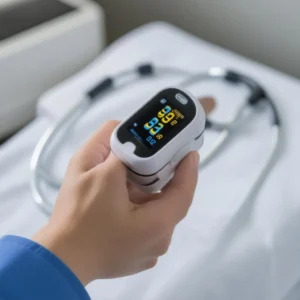Understanding the Normal Range for Pulse Oximeter Readings: A Comprehensive Guide
Meta Description:
What is the normal range for oximeter? Discover everything you need to know about pulse oximeter readings, their importance, and how to interpret them. Contact us for expert advice!
Introduction
Have you ever wondered how healthcare professionals monitor your oxygen levels so effortlessly? The answer lies in a small, portable device called a pulse oximeter. Whether you’re managing a chronic condition, recovering from an illness, or simply curious about your health, understanding what is the normal range for oximeter readings is crucial.
Pulse oximeters have become household essentials, especially after the COVID-19 pandemic. But what do those numbers on the screen really mean? In this comprehensive guide, we’ll break down everything you need to know about pulse oximeter readings, their significance, and how to interpret them correctly.
What is a Pulse Oximeter?
A pulse oximeter is a non-invasive medical device that measures two key metrics:
- Oxygen Saturation (SpO2): The percentage of oxygen in your blood.
- Pulse Rate: The number of heartbeats per minute.
This device is commonly clipped onto a finger, toe, or earlobe and uses light to estimate oxygen levels. It’s widely used in hospitals, clinics, and even at home for monitoring respiratory and cardiovascular health.
What is the Normal Range for Oximeter Readings?
Understanding what is the normal range for oximeter readings is essential for interpreting your results accurately. Here’s a breakdown:
1. Normal Oxygen Saturation (SpO2) Levels
- 95% to 100%: This is considered the normal range for healthy individuals.
- 90% to 94%: This range may indicate mild hypoxemia (low oxygen levels) and should be monitored closely.
- Below 90%: This is a cause for concern and may require immediate medical attention.
2. Normal Pulse Rate
- 60 to 100 beats per minute (bpm): This is the typical range for adults at rest.
- Above 100 bpm: This may indicate tachycardia (elevated heart rate).
- Below 60 bpm: This may suggest bradycardia (slow heart rate), which is normal for athletes but concerning for others.
Why is Monitoring Oxygen Saturation Important?
Monitoring your oxygen saturation levels is crucial for several reasons:
- Early Detection of Respiratory Issues: Low SpO2 levels can signal conditions like asthma, COPD, or pneumonia.
- COVID-19 Monitoring: During the pandemic, pulse oximeters became vital for detecting silent hypoxia.
- Post-Surgery Recovery: Patients are often monitored to ensure proper oxygen levels during recovery.
- High-Altitude Activities: Climbers and hikers use oximeters to prevent altitude sickness.
Factors That Affect Pulse Oximeter Readings
Several factors can influence the accuracy of your pulse oximeter readings:
- Nail Polish or Artificial Nails: These can interfere with light absorption.
- Poor Circulation: Cold hands or conditions like Raynaud’s disease may affect readings.
- Skin Pigmentation: Darker skin tones may sometimes lead to less accurate results.
- Motion Artifacts: Movement during measurement can cause errors.
- Altitude: Higher altitudes can naturally lower SpO2 levels.
How to Use a Pulse Oximeter Correctly
To ensure accurate readings, follow these steps:
- Warm Your Hands: Cold fingers can affect the device’s performance.
- Remove Nail Polish: Ensure your nails are clean and free of polish.
- Sit Still: Avoid moving during the measurement.
- Place the Device Correctly: Clip it onto your finger, toe, or earlobe as instructed.
- Wait for Stable Readings: It may take a few seconds for the device to display accurate results.
When to Seek Medical Attention
If your pulse oximeter readings fall outside the normal range, it’s important to take action:
- SpO2 Below 90%: Seek immediate medical attention.
- Persistent High or Low Pulse Rate: Consult a healthcare professional.
- Symptoms Like Shortness of Breath or Chest Pain: These may indicate a serious condition.
For personalized advice, feel free to contact us or reach out via WhatsApp.
Common Myths About Pulse Oximeters
Let’s debunk some common misconceptions:
- Myth: Pulse oximeters are only for sick people.
Fact: They’re useful for anyone monitoring their health, including athletes and frequent travelers. - Myth: All pulse oximeters are equally accurate.
Fact: Quality varies, so choose a device from a reputable brand. - Myth: A single low reading means you’re in danger.
Fact: Consistent low readings are more concerning than a one-time anomaly.
Choosing the Right Pulse Oximeter
Not all pulse oximeters are created equal. Here’s what to look for:
- Accuracy: Opt for FDA-approved devices.
- Ease of Use: Choose a user-friendly design.
- Display: Ensure the screen is clear and easy to read.
- Battery Life: Longer battery life is more convenient.
- Additional Features: Some devices offer Bluetooth connectivity or smartphone integration.
For high-quality medical devices, explore our product range.
Frequently Asked Questions (FAQs)
1. What is the normal range for oximeter readings?
The normal SpO2 range is 95% to 100%, and the normal pulse rate is 60 to 100 bpm.
2. Can pulse oximeters detect COVID-19?
While they can’t diagnose COVID-19, they can help detect low oxygen levels associated with the virus.
3. Are home pulse oximeters accurate?
Most home devices are reliable, but their accuracy depends on proper usage and quality.
4. How often should I check my oxygen levels?
This depends on your health condition. Consult your doctor for personalized advice.
5. Can I use a pulse oximeter during exercise?
Yes, it can help monitor your oxygen levels and heart rate during physical activity.
Conclusion
Understanding what is the normal range for oximeter readings is a vital step in taking control of your health. Whether you’re managing a chronic condition, recovering from an illness, or simply staying proactive, a pulse oximeter is a valuable tool.
If you have any questions or need assistance choosing the right device, don’t hesitate to contact us. Our team is here to help you make informed decisions about your health.


